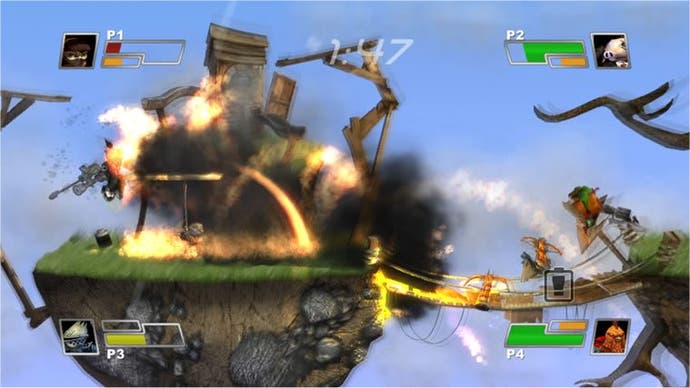Small Arms
Smashing.
Small Arms has been billed as Smash Bros. with guns, and that's a reasonable summary (unlike the weather outside these days, which is unreasonably wintery), but where you might imagine some sort of collusion between platforming combat and shoot-where-you-go gunnery, the controls are actually dual-stick, closer to something like Robotron.
And so players leap around manically, double-jumping and grabbing the edge of ledges, and as they go they're using the right analogue stick to aim and the triggers to fire off bullets, rockets, plasma, icicles, and even high-calibre sniper rounds. You can still go up to someone and punch them in the head, but it's actually a bit of an afterthought; the bulk of the combat is ranged, and sees you jumping to evade enemies rather than to meet them.
There are 12 combatants (four of which are unlockable) and eight stages (one unlockable), and as well as a health gauge you've also got an ammo meter to marshal, either replenishing it with pick-ups or picking up a new weapon, of which there are quite a few to replace your character's standard offering. You'd be wrong to expect the depth and diversity of a proper beat-'em-up though. Instead of special moves, the protagonists have default guns, but, with several life-bars to exhaust before death, you can expect a game in Small Arms to adopt a different timbre as often as new weapons present themselves. Characters effectively swap characteristics when they do.
Really it's the character of the levels that has the most impact on the scale and tactics of a match, and the eight provided are neatly varied. Most are static, having you hop around a particular single-screen environment trying to aim your projectiles between platforms, up and over the nose of a rocket in a silo, through holes in rotting logs and under canopies. Others scroll as you play, like a train-top level with multiple carriages, crane wagons and so on, and a weird tornado level where you're hopping from giant tyre to uprooted mansion to floating scaffold and so on. Some walk the line between the two, with moving elements or platforms that shatter under the weight of rockets.

Graphically the 360 does a lovely job of all of this, even if it's a bit dark in places (brighten up, Xbox developers!), and the little yelps and explosive effects mean it's obvious when you've hit someone, while an array of relatively simple achievements mean there's good cause for pillaging the single-player game several times over. Like Street Fighter's old-days barrel and car smash-up levels, there's also a shooting gallery that pops up between rounds, and there's a standalone version available in the main menu (although, once you've managed 10,000 points there for the achievement, you're unlikely to return often).
Offline there's also a Challenge mode, where your aim is to survive against a long sequence of AI adversaries. Like the main single-player game, you're often pitted against several at once, and this is likely where you'll focus most of your attention if your aim is to play Small Arms alone - the leaderboards are already alive with some worryingly impressive feats, and it's a good place to go to hone your targeting skills and shore up your defence.
That said, with characters swapping dynamics with every weapon-change and only eight levels, there isn't a huge amount here to hone, nor a great deal to encourage lone replay. All the characters have quirky outfits and silly back-stories (the cute little knight likes Renaissance fairs, the unlockable tree-man is pissed off that he's all alone in the world), but they don't have much else to distinguish them once you get into the flow of a game, and the actual plot is limited to a page on the options screen.

The weapons are all solid and fun to master, at least. You can fire bullets, green blobs, freeze rays, heat-seeking this, that and the other, William Tell inspired bow-cast explosive apples, even mines, and there's a handsome sword if you want to run after people shouting BANZAI. But even so there's nothing especially novel about any of your tools. It's more Unreal than Worms. And that lack of variety and novelty has a worrisome effect on the game's long-term prospects, particularly offline, where the AI can be really quite dreadful in places (happily sitting on the other side of a level waiting for you to pick it off, in the worst cases).
Then again, this isn't the sort of game designed to be played extensively on your own. The idea is to get some friends round or go online. In both areas Small Arms comes to life, but voice comms are a bit of a must if you're playing on Live. Otherwise playing with strangers can be a bit uninvolving and standoffish. Better to get a group together and gang up on each other.
Ultimately though it's none of these things that stops Small Arms short of greatness - even without the technical depth of a Street Fighter or Smash Bros., it's still riotously enjoyable in the right context. Instead what lets the side down is the controls. Having to move around, jump, aim and fire simultaneously is too hard to do comfortably, even if you can graduate from using the A button to favouring one of the bumpers for jumping.
It still feels clumsy, and while it's possible to overcome this in time and reach a decent standard, it robs the game of some of its accessibility - something critical to its multiplayer appeal - and your ultimate proficiency in moving, jumping and firing at the same time is only likely to announce itself long after you've exhausted what depths there are to excavate. Hopefully there'll be some reasonably priced downloadable content to keep things going and stave that fatigue off though, because Small Arms is certainly worthy of a trigger-happy Friday night, even if it can't quite match the spectacular genius of Smash Bros.

